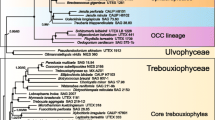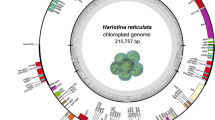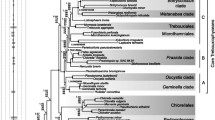Abstract
The kingdom Chromista contains eukaryotic organisms with tubular mastigonemes on the leading flagellum of their bi-flagellated stages, and plastids within a chloroplast endoplasmic reticulum (CER). The complex series of events leading to the formation of the CER is hypothesized to have occurred only once. Thus, all organisms with plastid-CER connections are believed to be monophyletic and derived from a single secondary endosymbiotic event. Analyses of sequence data from the 16s rRNA gene from three of the four Chromista pigmented classes indicate that these algae are not monophyletic. The validity of the kingdom Chromista and the number of secondary plastid endosymbioses are questioned.
Similar content being viewed by others
References
Barker GLA, Green JC, Hayes PK, Medlin LK (1994) Preliminary results using the RAPD analysis to screen bloom populations of Emiliania huxleyi (Haptophyta). Sarsia 79:301–306
Bhattacharya D, Medlin L (1995) The phylogeny of plastids: a review based on comparison of small subunit ribosomal RNA coding regions. J Phycol 31:487–496
Bhattacharya D, Medlin L, Wainwright PO, Ariztia EV, Bibeau C, Stickel SK, Sogin ML (1992) Algae containing chlorophylls a+c are polyphyletic: molecular evolutionary analysis of the Chromophyta. Evolution 46:1808–1817
Cavalier-Smith T (1981) Eukaryote kingdoms: seven or nine? Biosystems 14:461–481
Cavalier-Smith T (1982) The origins of plastids. Biol J Linn Soc 17:289–306
Cavalier-Smith T (1986) The kingdom Chromista: origin and systematics. In: Round FE, Chapman DJ (eds) Progress in phycological research, vol 4. Biopres Ltd., Bristol, pp 319–358
Cavalier-Smith T (1993) The kingdom Protozoa and its 18 phyla. Microbiol Rev 57:953–994
Cavalier-Smith T, Allsopp MTEP, Chao EE (1994) Chimeric conundra: are nucleomorphs and chromists monophyletic or polyphyletic? Proc Natl Acad Sci USA 91:11368–11372
Douglas SE, Turner S (1991) Molecular evidence for the origin of plastids from a cyanobacterium-like ancestor. J Mol Evol 33:267–273
Douglas SE, Murphy CA, Spencer DF, Gray MW (1991) Cryptomonad algae are evolutionary chimeras of two phylogenetically distinct unicellular eukaryotes. Nature 350:148–151
Doyle JJ, Doyle JL (1990) Isolation of plant DNA Focus 12:13–15
Engel H, Boggasch E, Huss VAR (1993) The unusual size of the plastome of some prymnesiophytes: new aspects in plastid evolution (abstract). The Biology of the Prymnesiophyta, Plymouth, UK
Felsenstein J (1985) Confidence limits on phylogenies: an approach using the bootstrap. Evolution 39:783–791
Felsenstein J (1993) PHYLIP manual, Version 3.5 Department of Genetics, University of Washington, Seattle
Fitch WM, Margoliash E (1967) Construction of phylogenetic trees: a method based on mutation distances as estimated from cytochrome c sequences is of general applicability Science 155:279–284
Fujiwara S, Sawada MH, Someya J, Minaka N, Nishikawa S (1994) Molecular phylogenetic analysis of the rbcL in Prymnesiophyta. J Phycol 30:863–871
Gibbs S (1962) Nuclear-envelope-chloroplast relationships in algae. J Cell Biol 14:433–444
Gibbs S (1981) The chloroplasts of some algal groups may have evolved from endosymbiotic eukaryotic algae. Ann NY Acad Sci 361:193–207
Gibbs S (1993) The evolution of algal chloroplasts. In: Lewin RA (ed) Origins of plastids. Chapman and Hall, New York, pp 107–121
Giovannoni SJ, Turner S Olsen GJ, Barns S, Lane DJ, Pace NJ (1988) Evolutionary relationships among the cyanobacteria and green chloroplasts. J Bacteriol 170:3584–3592
Giovannoni SJ, Wood N, Huss VAR (1993) Molecular phylogeny of oxygenic cells and organelles based on small-subunit ribosomal RNA sequences. In: Lewin RA (ed) Origins of plastids. Chapman and Hall, New York, pp 159–170
Gutell RR (1993) Collection of small subunit (16s and 16s-like) ribosomal RNA structures. Nucleic Acids Res 21:3051–3054
Helmchen T, Bhattacharya D, Melkonian M, (1995) Analyses of ribosomal RNA sequences from glaucocystophyte cyanelles provide new insights into the evolutionary relationships of plastids. J Mol Evol 41:203–210
Hillis DM, Huelsenbeck JP, Cunningham CW (1994) Application and accuracy of molecular phylogenies. Science 264:671–677
Kimura M (1980) A simple method for estimating evolutionary rates of base substitution through comparative studies of sequence evolution. J Mol Evol 16:111–120
Larsen L, Olsen GJ, Maidak BL, McCaughey MJ, Overbeek R, Macke R, Marsh TL, Woese CR (1993) The ribosomal database project. Nucleic Acids Res 21 (suppl) 3021–3023
Laval-Peuto M (1992) Plastidic Protozoa. In: Reisser N (ed) Algae and symbioses. Biopress Ltd., Bristol, pp 471–499
Lockhart PJ, Howe CJ, Bryant DA, Beanland MD, Penny D (1994) Substitutional bias confounds inference of cyanelle origins from sequence data J Mol Evol 34:153–162
Maddison WP, Maddison DR (1992) MacClade. Analysis of phylogeny and character evolution. Version 3. Sinauer Associates, Sunderland
Markowicz Y, Loiseaux-de Goër S (1991) Plastid genomes of the Rhodophyta and the Chromophyta constitute a distinct lineage which differs from that of the Chlorophyta and have a composite phylogenetic origin, perhaps like that of the Euglenophyta. Curr Genet 20:427–430
Martin W, Sommerville CC, Loiseaux-de Goër S (1992) Molecular phylogenies of plastid origins and algal evolution. J Mol Evol 35:385–404
Medlin LK, Crawford RM, Andersen RA (1986) Histochemical and ultrastructural evidence for the function of the labiate process in the movement of centric diatoms. Br phycol J 21:297–301
Medlin L, Elwood HJ, Stickel S, Sogin MI (1988) The characterization of enzymatically amplified eukaryotic 16s-like rRNA-coding regions. Gene 71:491–499
Morden CW, Delwiche CF, Kuhsel M, Palmer JD (1992) Gene phylogenies and the endosymbiotic origin of plastids. BioSystems 28:75–90
Neefs J-M, van de Peer Y, Derijk P, Goris A, Dewachter R (1991) Compilation of small ribosomal subunit RNA sequences. Nucleic Acid Res 19 (suppl): 1987–2015
Ragan MA, Bird CJ, Rice EL, Gutell RR, Murphy CA Singh RK (1994) A molecular phylogeny of the marine red algae (Rhodophyta) based on the nuclear small-subunit rRNA gene. Proc Natl Acad Sci USA 91:7276–7280
Saiki R, Gelfand DH, Stoffel S, Scharf SJ, Higuchi R, Horn GT, Mullis KB, Erlich HA (1988) Primer-directed enzymatic amplification of DNA with a thermostable DNA polymerase. Science 239:487–491
Saitou N, Nei M (1987) The neighbor-joining method: a new method for reconstructing phylogenetic trees. Mol Biol Evol 4:406–425
Sanger F, Nicklen S, Coulsen AR (1977) DNA sequencing with chain-terminating inhibitors. Proc Natl Acad Sci USA 74:5463–5467
Saunders GW, Potter D, Paskind MP, Andersen RA (1995) Cladistic analyses of combined traditional and molecular data sets reveal a new algal lineage. Proc Natl Acad Sci USA 38:244–248
Schnepf E (1993) From prey via endosymbiont to plastid comparative studies in dinoflagellates. In: Lewin RA (ed) Origins of plastids. Chapman and Hall, New York, pp 53–76
Swofford DL (1993) PAUP: Phylogenetic analysis using parsimony, V3.1 Natural History Survey, Champaign
Whatley JM (1993a) Chloroplast ultrastructure In: Berner T (ed) Ultrastructure of microalgae. CRC Press, Boca Raton, Florida, pp 135–204
Whatley JM (1993b) Membranes and plastid origins. In: Lewin RA (ed) Origins of plastids. Chapman and Hall, New York, pp 77–106
Author information
Authors and Affiliations
Additional information
Communicated by M.V. Ciriacy
Rights and permissions
About this article
Cite this article
Medlin, L.K., Cooper, A., Hill, C. et al. Phylogenetic position of the Chromista plastids based on small subunit rRNA coding regions. Curr Genet 28, 560–565 (1995). https://doi.org/10.1007/BF00518169
Received:
Accepted:
Issue Date:
DOI: https://doi.org/10.1007/BF00518169




